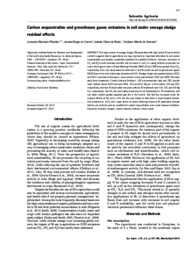Carbon sequestration and greenhouse gases emissions in soil under sewage sludge residual effects.
Carbon sequestration and greenhouse gases emissions in soil under sewage sludge residual effects.
Author(s): PITOMBO, L. M.; CARMO, J. B.; DE MARIA, I. C.; ANDRADE, C. A. de
Summary: Abstract: The large volume of sewage sludge (SS) generated with high carbon (C) and nutrient content suggests that its agricultural use may represent an important alternative to soil carbon sequestration and provides a potential substitute for synthetic fertilizers. However, emissions of CH4 and N2O could neutralize benefits with increases in soil C or saving fertilizer production because these gases have a Global Warming Potential (GWP) 25 and 298 times greater than CO2, respectively. Thus, this study aimed to determine C and N content as well as greenhouse gases (GHG) fluxes from soils historically amended with SS. Sewage sludge was applied between 2001 and 2007, and maize (Zea mays L.) was sowed in every year between 2001 and 2009. We evaluated three treatments: Control (mineral fertilizer), 1SS (recommended rate) and 2SS (double rate). Carbon stocks (0-40 cm) were 58.8, 72.5 and 83.1 Mg ha?1 in the Control, 1SS and 2SS, respectively, whereas N stocks after two years without SS treatment were 4.8, 5.8, and 6.8 Mg ha?1, respectively. Soil CO2 flux was highly responsive to soil temperature in SS treatments, and soil water content greatly impacted gas flux in the Control. Soil N2O flux increased under the residual effects of SS, but in 1SS, the flux was similar to that found in moist tropical forests. Soil remained as a CH4 sink. Large stores of carbon following historical SS application indicate that its use could be used as a method for carbon sequestration, even under tropical conditions.
Publication year: 2015
Types of publication: Journal article
Unit: Embrapa Environment
Observation
Some of Embrapa's publications are published as ePub files. To read them, use or download one of the following free software options to your computer or mobile device. Android: Google Play Books; IOS: iBooks; Windows and Linux: Calibre.
Access other publications
Access the Agricultural Research Database (BDPA) to consult Embrapa's full library collection and records.
Visit Embrapa Bookstore to purchase books and other publications sold by Embrapa.

